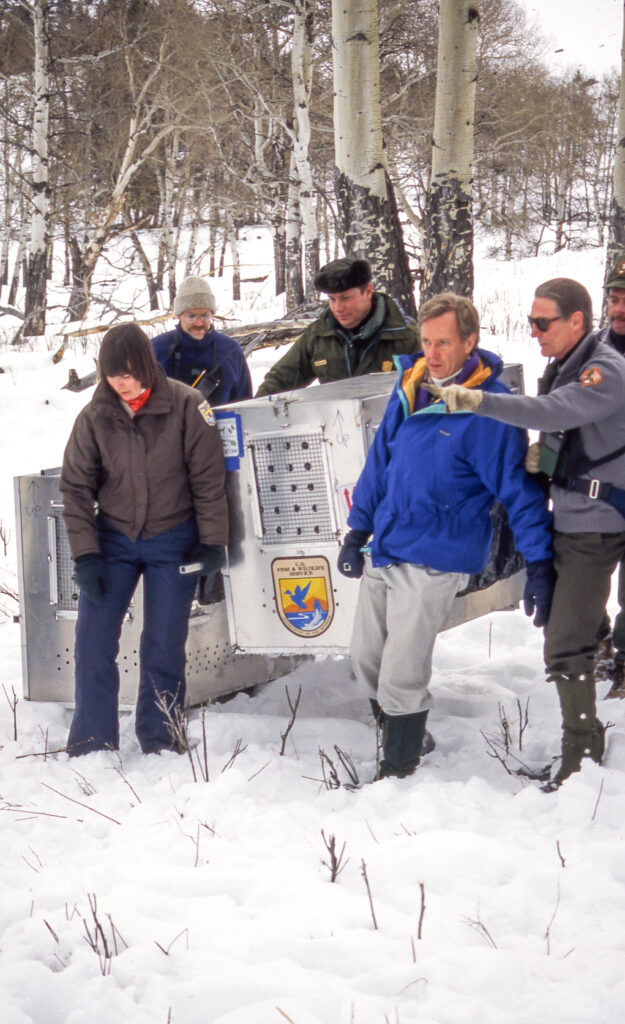
What is your background regarding wolves?
When I was three, and my sisters were six and four, my mother read us The Three Little Pigs. We lived a block south of the Denver zoo, and could hear lions roaring and peacocks crowing. We could also hear steam trains chuffing at the Union Station a couple of miles away. I slept alone in the basement, and thought the chuffing was wolves blowing houses down. A baby sitter told me that if I didn’t behave, the wolf would get me. My mother relieved my fear of that fate by taking me down into the basement and showing me as she threw the Three Little Pigs book into the coal-burning furnace, and telling me that the wolf was gone.
The topic of wolves didn’t arise again until I was taking graduate courses in Forest Recreation and Wildlife Management at CSU, when my major professor introduced my class to Aldo Leopold’s A Sand County Almanac, and we read Leopold’s essay, “Thinking Like a Mountain,” in which he tells about killing a wolf, and through his career, recognizing that predators were essential to the health of ecosystems.
After working as a national park ranger at Rocky Mountain, Death Valley, Yosemite, Mount Rainier, and the Southeast Regional Office, I was attending a professional meeting in Minneapolis, where Barry Holstun Lopez was signing his 1978 Of Wolves and Men. I bought it.
When you learned wolves were going to be reintroduced to Yellowstone, what was your reaction?
Two years later, I was transferred from Atlanta to Yellowstone, as resource management specialist. Within the first several months I was there, the 1980 Northern Rocky Mountain Wolf Recovery Plan arrived in the park. I was ecstatic. One morning I ran into superintendent John Townsley in the mail room, and something keyed both of us to think about the wolf plan. I started to say something about it, but he held up a finger and said, “We will not mention wolves until we have the grizzly bear on a sound footing in Yellowstone.” He knew each of the members of Congress from the three states surrounding the park, and realized that even mentioning another endangered species to them could destroy any chance of conserving either one.
What did you think would happen with reintroduction vs. what did happen?
None of us thought wolves would be as visible as they turned out to be. Few people were seeing wolves in Denali or on Isle Royale. Ten years after the wolves arrived, an estimated 300,000 visitors were viewing wolves annually, and spending $35.5 million in local communities. Now the annual benefit to surrounding counties from wolf watching is $65.5 million.
Through a series on inter-park transfers, by 1985 I was serving as resources interpreter in the newly established Yellowstone Center for Resources. The second Northern Rocky Mountain Wolf Recovery Plan was completed that year, and finally approved in 1987. In ensuing months, throughout the region, I gave 400 talks on wolves and their recovery, and sent thousands of custom packages of wolf information to universities and high school students who requested information about wolf restoration. I also helped produce two reports to Congress: Wolves for Yellowstone?, served the wolf Management Committee of 1991, and worked with the USFWS on the preparation of the 1994 EIS, The Reintroduction of Gray Wolves to Yellowstone National Park and Central Idaho.
When the EIS was signed in 1994, and wolves were finally transported to Yellowstone in January, 1995, I helped carry them to acclimation pens, and helped feed them in the pens. In 1997, I retired, but from 1999 to 2005, taught field courses on wolves for the Yellowstone Institute.
What is the most surprising thing you have learned about wolf behavior?
Three books by Rick McIntyre, who has been observing the wolves almost daily for 25 years: The Rise of Wolf 8, The Reign of Wolf 21, and The Redemption of Wolf 302, reveal the complexity of wolf family life. Each wolf has a unique personality, and is guided by learning from his or her parents and the wolf’s own experience.
Why do you think wolves continue to be so polarizing in our society?
Hatred appears to me to be a very compelling and attractive emotion. Fear is another gripping sensation, and we humans seem to groove on it. Look at all the horror movies. We love to scare each other. The guy at the bar who can tell the scariest story is the center of attention. Fear and hatred justify inordinate acts of cruelty toward wolves and other predators.
Barry Lopez (1978, P. 196) writes toward the end of a chapter in An American Pogrom with: “It seems to me that somewhere in our history we should have attempted to answer to ourselves for all this. As I have tried to make clear, the motives for wiping out wolves (as opposed to controlling them) proceeded from misunderstanding, from illusions as to what constituted sport, from strident attachment to private property, from ignorance and irrational hatred. But the scope, the casual irresponsibility, and the cruelty of wolf killing is something else. I don’t think it comes from some base, atavistic urge, though that may be part of it,.I think it is that we simply do not understand our place in the universe and have not the courage to admit it.”
What is one thing you think people should know about wolves?
That they are the least dangerous of all North American wild animals. We have only two reports of human fatalities caused by wild wolves in the last 90 years. Beyond that, that they are essential to the health of the very animals we fear they will eliminate.
Do you think grizzly bears should be reintroduced to their original habitats as well?
As an old acquaintance used to say, “That’s a whole ‘nuther smoke, friends.” Wolves need only two things: adequate vulnerable prey, and human tolerance. Grizzly bears present a whole different panoply of issues.
Do you think wolf reintroduction in Montana, Wyoming and Idaho has been managed well? What do you think the pitfalls and successes have been?
Wolves in the three states have been at the mercy of a number of different administrations, the latest of which in Idaho and Montana have been disastrous. At a time when chronic wasting disease is advancing through the deer, elk, and moose in all three states, not one of them has given serious thought of allowing wolves to perform their essential role of sanitarian, and instead have resurrected old hatreds and crane killing methods like those documented by Lopez and others. I find it very disheartening, in view of the current ongoing Sixth Extinction.


